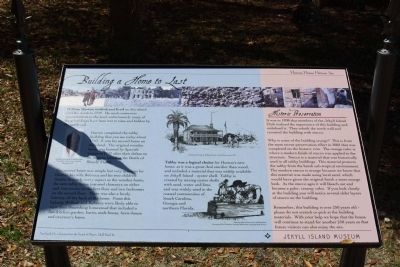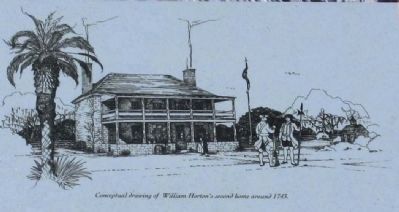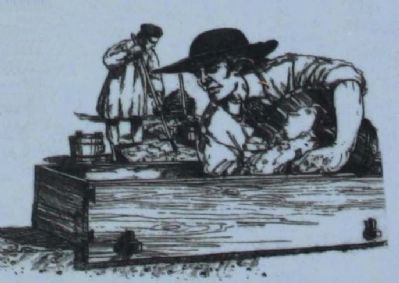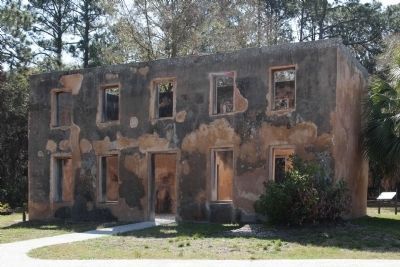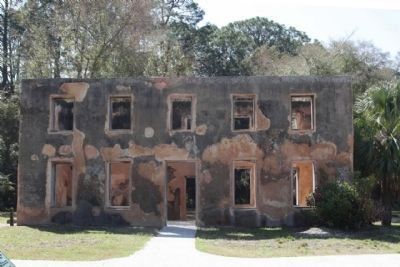Jekyll Island in Glynn County, Georgia — The American South (South Atlantic)
Horton House Historic Site
Building a Home to Last
— Jekyll Island —
William Horton worked and lived on this island until his death in 1748. He made numerous improvements to the land, unfortunately many of these buildings have been lost to time, and hidden by the sandy soil.
Horton completed the tabby building that you see today about 1743. It was his second home on the island. The original wooden home was burned by Spanish troops in 1742 after their defeat on St. Simons Island at the Battle of Bloody Marsh.
The second home was simple but very spacious for Horton, his wife Rebecca and two children. Similar in nearly every aspect as the wooden home, the new tabby home featured chimneys on either end, two rooms on the first floor and two bedrooms on the second floor. There was also a lovely balcony off the back of the home. From this balcony William and Rebecca were likely able to view their flourishing homestead that included a fine kitchen garden, barns, malt-house, brew-house and overseer's home.
Tabby was a logical choice for Horton's new home, as it was a great deal sturdier than wood, and included a material that was widely available on Jekyll Island - oyster shell. Tabby is created by mixing oyster shells with sand, water and lime, and widely used in the coastal communities of South Carolina, Georgia and northern Florida.
Historic Preservation
It was in 1898 that members of the Jekyll Island Club realized the importance of this building and stabilized it. They rebuilt the north wall and recoated the building with stucco.
Why is some of this building orange? This is from the most recent preservation effort in 2002 that was completed on the historic ruin. The orange color is where a modern finish of stucco was applied to the structure. Stucco is a material that was historically used in all tabby buildings. This material protects the tabby from the harsh sub-tropical environment. The modern stucco is orange because we know that this material was made using local sand, which would have given the original finish a more orange look. As the stucco ages it will bleach out and become a paler, creamy color. If you look closely at the building you will notice several older layers of stucco on the building.
Remember, this building is over 250 years old - please do not scratch or pick at the building materials. With your help we hope that the house will continue to stand for another 250 years so that future visitors can also enjoy the site.
Erected by Friends of Historic Jekyll Island, Inc. and Jekyll Island Museum.
Topics. This historical marker is listed in these topic lists: Colonial Era • Settlements & Settlers. A significant historical year for this entry is 1748.
Location.
31° 6.107′ N, 81° 24.874′ W. Marker is on Jekyll Island, Georgia, in Glynn County. Marker is at the intersection of Riverview Drive and Major Horton Road, on the right when traveling north on Riverview Drive. Touch for map. Marker is in this post office area: Jekyll Island GA 31527, United States of America. Touch for directions.
Other nearby markers. At least 8 other markers are within walking distance of this marker. Major William Horton (here, next to this marker); Tabby (a few steps from this marker); Poulain du Bignon and du Bignon Burying Ground (within shouting distance of this marker); a different marker also named Horton House Historic Site (within shouting distance of this marker); Horton House (within shouting distance of this marker); Horton House Harvest (within shouting distance of this marker); a different marker also named Horton House Historic Site (within shouting distance of this marker); Le Sieur Christophe Anne Poulain du Bignon (about 300 feet away, measured in a direct line). Touch for a list and map of all markers in Jekyll Island.
Regarding Horton House Historic Site. These are the remains of Horton`s tabby house. Major Horton of Oglethorpe`s Regiment, the first English resident of Jekyll Island, erected on the north end of Jekyll a two-story dwelling and large barn. He cleared fields here for cultivation of crops which supplied the settlers at Frederica on St. Simons Island,
a neighboring island, who would have suffered except for this assistance. Major Horton cut a road across the north end of Jekyll, running east and west, from this tabby house to the beach. Major Horton was a trusted officer chosen by James Oglethorpe for important missions. Upon Oglethorpe`s final return to England in 1743, Major Horton succeeded him as commander of the military forces of the Colony of Georgia.
Poulain du Bignon, owner of Jekyll Island after the Revolutionary War, repaired the Horton tabby house and made it his home. As the du Bignon family grew, wooden wings were added to the house.
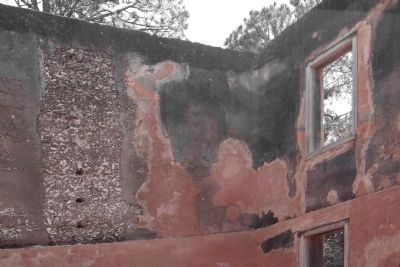
Photographed By Mike Stroud, March 18, 2009
5. Horton House, inside wall view, tabby and stucco
The orange color is (as mentioned on marker) where a modern finish of stucco was applied to the structure. Stucco is a material that was historically used in all tabby buildings. This material protects the tabby from the harsh sub-tropical environment. The modern stucco is orange because we know that this material was made using local sand, which would have given the original finish a more orange look. As the stucco ages it will bleach out and become a paler, creamy color.
Credits. This page was last revised on November 17, 2020. It was originally submitted on March 22, 2009, by Mike Stroud of Bluffton, South Carolina. This page has been viewed 1,763 times since then and 35 times this year. Photos: 1, 2, 3, 4, 5, 6. submitted on March 22, 2009, by Mike Stroud of Bluffton, South Carolina. • Kevin W. was the editor who published this page.
